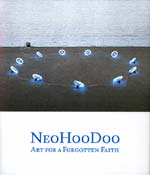
|

|
|
Home Site Search Contact Us Subscribe
|
|
|
Book Review: "NeoHooDoo: Art for a Forgotten Faith," edited by Franklin Sirmans: Sharpen your pencils - and get ready to do a NeoHooDoo shimmy This audacious book is a welcome reminder that no term in contemporary architectural design is as taboo as "vernacular spiritual." By Norman Weinstein August 26, 2008 In the swirl of Post-Katrina writing, remarkably little light has been shed on the need to rebuild shotgun houses keeping an African aesthetic perspective in the forefront of awareness. The need to do so might seem pale in light of the overwhelming human tragedy calling for relief, shotgun “authenticity” or “African roots” be damned, some might say.
But suppose an awareness of the African foundation of New Orleans is actually a core issue in the residential rebuilding of the city? To even begin to “try on” such a seemingly outlandish perspective entails opening doors to a generally verboten topic in contemporary architectural writing: the African-American vernacular spiritual aesthetic.
That is why I strongly suggest all architects interested in the rebuilding of shotgun housing in New Orleans take a good long look at NeoHooDoo: Art for a Forgotten Faith, a just-published exhibition catalog published by The Menil Collection, and distributed by Yale University Press. The catalog offers a range of conventional and unconventional art objects from the current exhibition of the same name at The Menil Collection in Houston, framed by major essays by scholars and creative artists concerned with African spirituality infusing American art.
While the New Orleans shotgun house, pre- or post-Katrina, is referenced only fleetingly and indirectly, the lessons architects can learn from these essays and reproductions are enormous. The shotgun house was an African American invention reflecting the traditional African belief that a narrow house with sequential rooms, allowing ventilation an easy flow from front door to back, is simultaneously a material shelter and a spiritual highway. High velocity spirits are not trapped in a shotgun house, raising havoc for its dwellers. In those rare cases where the front and rear doors of a shotgun house are misaligned, there is a rationale explaining why the builder might want a spirit trapped in a domicile. To paraphrase Le Corbusier, in the vernacular Afro-Atlantic architectural heritage, architecture is the play of spirit across volumes. You don’t mine the deepest meanings of a shotgun house by strolling past it. You imagine yourself circulating through it with the lightness of a spirit finding itself intensely, wondrously bewildered in space.
If an architect rebuilding a shotgun house accepts this historic reality, a neo-shotgun house is more than a surface material replication of a structural form. It is actually what the writers and visual artists in the Menil exhibit would call a dynamic construction actualizing a spirit form latent in materials, struggling to be born. If this sounds too HooDoo-mystical for your liking, consider how mainstream architecture has embraced the notion of virtual form. Suppose the virtual is the favorite spirit-form of high-tech architecture. To design a structure virtually is to play with energies latent in actual material forms, which can explain why BIM can create such fetching unbuildable (in the material world) structures. Think of BIM as a secularized version of a stained glass window, a liminal filter between materiality and possible materialization. Then look in this handsome text at art works by Gary Simmons and David Hammons based on African American bottle trees (based on the folk belief that bottles on branch tips “collect” spirits). The bottles in Simmons’ bronze and glass sculpture and Hammon’s glass ring also operate in the twilight zone between immateriality-with-the-possibility-of-becoming-tangible (e.g., virtuality), and materiality.
This audacious book is a welcome reminder that no term in contemporary architectural design is as taboo as “vernacular spiritual.” The reconstruction of New Orleans, if it emerges as something other than an architectural theme park of its largely African-American residential heritage, depends of the return of that repressed reality. To bring that repressed reality back, architects might need a working definition of design as the play of invisibilities coming into visibility through intellectual, aesthetic, and spiritual intentions to transmute materials into living processes. Sharpen your pencils – and get ready to do a NeoHooDoo shimmy.
“NeoHooDoo: Art for a Forgotten Faith” exhibition schedule: ● The Menil Collection, Houston (through September 21, 2008) ● P.S.1 Contemporary Art Center, New York (October 19, 2008 – January 26, 2009) ● Miami Art Museum, Florida (February 20 – May 24, 2009)
Norman Weinstein authors the ArchNewsNow monthly series “Words That Build.” He also writes for Architectural Record and other publications, and teaches communication skills to architects. He can be reached at nweinste@mindspring.com.
|
(click on pictures to enlarge) 
|
© 2008 ArchNewsNow.com